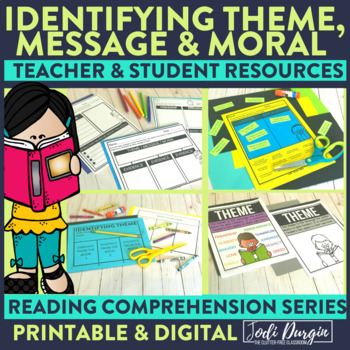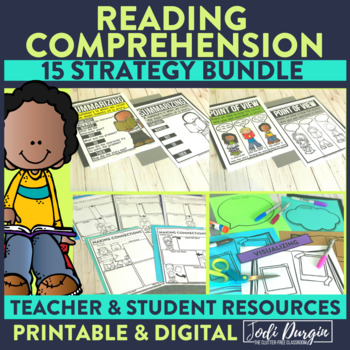Identifying theme, message or moral is an important reading comprehension strategy for elementary students to become proficient in. It helps readers better understand and enjoy stories they read and listen to. When readers identify the theme, message or moral, they are taking what they already know about life and pairing it with the action and events from the story to decide what the author wants them to learn. Readers then consider how that idea can be related to their own life and how it can help them. Learn all about how to teach theme, message, and moral below!
What is Theme, Message, and Moral?
All authors have a lesson or message they want to give readers. It is important for students to learn that we read in order to learn things that will help us in our own lives. This reading strategy is commonly referred to as identifying the theme, message, or moral of the story.
The theme of a story is the message that the author is giving to readers. It is a big idea that readers can apply to their own lives. A book can have more than one theme or message. This is because the author does not directly state the theme. Instead, it is up to interpretation. Readers identify the theme through inferencing. You can often find the theme in the characters, setting and action of a story. Usually, the main character in a story grows and changes throughout and observing how the character responds can help us identify the theme.
Similarly, the moral of a story is the lesson that can be learned. Often, the author directly states or implies the moral. We typically find the moral of a story in fables. Authors of fables usually tell the moral of the story at the end.
When identifying the theme, message or moral, readers are taking what they already know about life and pairing it with the action and events from the story to decide what the author wants them to learn. Readers will then consider how that theme can be related to their own life and how it can help them.
Why are Theme, Message, and Moral Important Comprehension Strategies?
The ability to identify the theme, message or moral is a skill students will use throughout their school career. It is important that students learn how to identify the theme starting at an early age.
By identifying the message, readers gain a better understanding of the main character: their challenges, experiences, and feelings. In doing so, they have a deep comprehension of the text as a whole because they are realizing the meaning behind the story as a whole, as well as why the author felt it was important to write and share with others.
Once students learn that the stories they’re reading have meaning, they are more engaged in the text. They realize that there is something to learn and are able to connect to the story. Identifying the theme leaves readers with something they can continue to think about even after reading, and sometimes causes readers to take action.
Typically, the theme, message and moral of a story are lessons that build character and teach life lessons. This helps students to learn how to be a good person and make good choices.
Teaching Standards for Theme, Message, and Moral
Below is a list of standards for this reading comprehension topic. These standards are from the Common Core State Standards and Texas Essential Knowledge and Skills.
CCSS
- RL.1.2 – Retell stories, including key details, and demonstrate understanding of their central message or lesson.
- RL.2.2 – Recount stories, including fables and folktales from diverse cultures, and determine their central message, lesson, or moral.
- RL.3.2 – Recount stories, including fables, folktales, and myths from diverse cultures; determine the central message, lesson, or moral and explain how it is conveyed through key details in the text.
- RL.4.2 – Determine a theme of a story, drama, or poem from details in the text; summarize the text.
- RL.5.2 – Determine a theme of a story, drama, or poem from details in the text, including how characters in a story or drama respond to challenges or how the speaker in a poem reflects upon a topic; summarize the text.
TEKS
- Grade 1
- ELA.1.6.G – Evaluate details to determine what is most important with adult assistance.
- ELA.1.7.D – Retell texts in ways that maintain meaning.
- ELA.1.8.A – Discuss topics and determine theme using text evidence with adult assistance.
- Grade 2
- ELA.2.6.G – Evaluate details read to determine key ideas.
- ELA.2.7.D – Retell and paraphrase texts in ways that maintain meaning and logical order.
- ELA.2.8.A – Discuss topics and determine theme using text evidence with adult assistance.
- Grade 3
- ELA.3.6.G – Evaluate details read to determine key ideas.
- ELA.3.7.D – Retell and paraphrase texts in ways that maintain meaning and logical order.
- ELA.3.8.A – Infer the theme of a work, distinguishing theme from topic.
- Grade 4
- ELA.4.6.G – Evaluate details read to determine key ideas.
- ELA.4.7.D – Retell, paraphrase, or summarize texts in ways that maintain meaning and logical order.
- ELA.4.8.A – Infer basic themes supported by text evidence.
- Grade 5
- ELA.5.6.G – Evaluate details read to determine key ideas.
- ELA.5.7.D – Retell, paraphrase, or summarize texts in ways that maintain meaning and logical order.
- ELA.5.8.A – Infer multiple themes within a text using text evidence.
3 Tips for Teaching Students to Identify the Theme, Message, or Moral
Below are suggestions for when you’re teaching your students to identify the theme, message, and moral when reading.
1. Read Aloud Picture Books
Reading aloud picture books is a great way to model and practice this reading comprehension strategy. There are tons of great read alouds for teaching theme, message, and moral. Some high-quality examples include Bad Apple: A Tale of Friendship, Chopsticks, Strictly No Elephants, The Jelly Donut Difference, and Alexander and the Terrible, Horrible, No Good, Very Bad Day.
2. Make Anchor Charts
Anchor charts are another great way to teach students about identifying the theme, message, and moral in children’s books. My theme, message, and moral resource includes an interactive anchor chart that successfully engages students in their learning and provides a visual learning experience for students to learn about identifying the theme, message, and moral.
3. Use Videos
The third on the list of tips for teaching students to identify the theme, message, and moral is playing videos. This is another great visual learning opportunity for students to learn about what can feel like a very abstract idea. Below are some examples of videos that are great for teaching students how to identify the theme, message, and moral in picture books.
- https://www.youtube.com/watch?v=MAu3e5GZo4k
- https://jr.brainpop.com/readingandwriting/storyelements/theme/
Theme, Message, and Moral Resources
These printable and digital resources for teaching elementary students about identifying theme, message, and more make curriculum and lesson planning quick and easy. It includes teacher, parent, and student resources, so you’ll have everything you need to deliver meaningful research-based instruction rooted in current best practices.
What the Resource Includes
1. Teacher Resources
There are teacher notes about the strategy, teaching ideas, a planning page with question prompts, and list of mentor texts, so you have all of the information you need to plan a research and standards-based reading unit based on this reading comprehension strategy.
2. Parent Resources
There is a parent letter and a reading log with suggested question prompts so parents can confidently support and reinforce the strategy you are teaching with their children at home.
3. Instructional Resources
There are printables to create a large anchor chart and reference charts. Both save you lots of time searching for anchor chart ideas and supplemental teaching tools.
4. Student Resources
There are 3 printables and 2 activities for students that provide meaningful opportunities to practice and make sense of the reading strategy in a fun and engaging way
5. Digital Resources
There are digital versions of several of the resources so students can access them in school or at home using a technology device of their choice.
Why Teachers Love this Resource
- This collection of resources is versatile. Use the activities on their own or as a supplement to any reading curriculum. You will be able to continue to use these resources if your school adopts a new reading program or you switch school districts.
- This resource is part of a larger collection of reading strategy products, so you can provide a consistent instructional approach that your students quickly learn and understand the expectations and routines for. Learn more about this collection here!
- It’s a huge time saver! Instead of hunting for background information on a reading strategy and then searching for resources to teach the strategy, this comprehensive resource includes all of the information and resources you need to teach a whole unit on this reading strategy.
- The student activities are a lot of fun for students. This helps create a productive learning environment where students are engaged and learning!
- It includes resources that provide a great way to create a home-school connection with students’ families and support parents/guardians in continuing student learning at home.
In closing, we hope you found this post about how to teach theme, message, and moral helpful! If you did, then you may also be interested in this other post about elementary reading comprehension strategies. It provides elementary teachers helpful information about teaching reading strategies.




